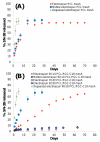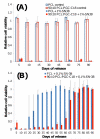Superhydrophobic materials for tunable drug release: using displacement of air to control delivery rates
- PMID: 22279966
- PMCID: PMC3878812
- DOI: 10.1021/ja211148a
Superhydrophobic materials for tunable drug release: using displacement of air to control delivery rates
Abstract
We have prepared 3D superhydrophobic materials from biocompatible building blocks, where air acts as a barrier component in a porous electrospun mesh to control the rate at which drug is released. Specifically, we fabricated poly(ε-caprolactone) electrospun meshes containing poly(glycerol monostearate-co-ε-caprolactone) as a hydrophobic polymer dopant, which results in meshes with a high apparent contact angle. We demonstrate that the apparent contact angle of these meshes dictates the rate at which water penetrates into the porous network and displaces entrapped air. The addition of a model bioactive agent (SN-38) showed a release rate with a striking dependence on the apparent contact angle that can be explained by this displacement of air within the electrospun meshes. We further show that porous electrospun meshes with higher surface area can be prepared that release more slowly than control nonporous constructs. Finally, the entrapped air layer within superhydrophobic meshes is shown to be robust in the presence of serum, as drug-loaded meshes were efficacious against cancer cells in vitro for >60 days, thus demonstrating their applicability for long-term drug delivery.
© 2012 American Chemical Society
Figures






Similar articles
-
3D superhydrophobic electrospun meshes as reinforcement materials for sustained local drug delivery against colorectal cancer cells.J Control Release. 2012 Aug 20;162(1):92-101. doi: 10.1016/j.jconrel.2012.05.047. Epub 2012 Jun 6. J Control Release. 2012. PMID: 22684120 Free PMC article.
-
A Mechanistic Study of Wetting Superhydrophobic Porous 3D Meshes.Adv Funct Mater. 2013 Aug 7;23(29):3628-3637. doi: 10.1002/adfm.201203111. Adv Funct Mater. 2013. PMID: 25309305 Free PMC article.
-
Layered superhydrophobic meshes for controlled drug release.J Control Release. 2015 Sep 28;214:23-9. doi: 10.1016/j.jconrel.2015.06.042. Epub 2015 Jul 6. J Control Release. 2015. PMID: 26160309 Free PMC article.
-
Porous organic polymers for drug delivery: hierarchical pore structures, variable morphologies, and biological properties.Biomater Sci. 2022 Sep 27;10(19):5369-5390. doi: 10.1039/d2bm00719c. Biomater Sci. 2022. PMID: 35861101 Review.
-
Electrospun-Based Membranes as a Key Tool to Prevent Respiratory Infections.Polymers (Basel). 2022 Sep 10;14(18):3787. doi: 10.3390/polym14183787. Polymers (Basel). 2022. PMID: 36145931 Free PMC article. Review.
Cited by
-
A facile approach to robust superhydrophobic 3D coatings via connective-particle formation using the electrospraying process.Chem Commun (Camb). 2013 Jan 28;49(8):804-6. doi: 10.1039/c2cc38012a. Chem Commun (Camb). 2013. PMID: 23235806 Free PMC article.
-
Early stage release control of an anticancer drug by drug-polymer miscibility in a hydrophobic fiber-based drug delivery system.RSC Adv. 2018 May 29;8(35):19791-19803. doi: 10.1039/c8ra01467a. eCollection 2018 May 25. RSC Adv. 2018. PMID: 35540999 Free PMC article.
-
Micro/Nanopatterned Superhydrophobic Surfaces Fabrication for Biomolecules and Biomaterials Manipulation and Analysis.Micromachines (Basel). 2021 Nov 30;12(12):1501. doi: 10.3390/mi12121501. Micromachines (Basel). 2021. PMID: 34945349 Free PMC article. Review.
-
Novel Honokiol-eluting PLGA-based scaffold effectively restricts the growth of renal cancer cells.PLoS One. 2020 Dec 17;15(12):e0243837. doi: 10.1371/journal.pone.0243837. eCollection 2020. PLoS One. 2020. PMID: 33332399 Free PMC article.
-
Altering the Surface Properties of Metal Alloys Utilizing Facile and Ecological Methods.Langmuir. 2022 Apr 26;38(16):4826-4838. doi: 10.1021/acs.langmuir.1c03431. Epub 2022 Apr 14. Langmuir. 2022. PMID: 35421312 Free PMC article.
References
-
- Li X-M, Reinhoudt D, Crego-Calama M. Chem. Soc. Rev. 2007;36:1350. - PubMed
-
- Wenzel RN. J. Ind. Eng. Chem. 1936;28:988.
-
- Cassie ABD, Baxter S. T Far. Soc. 1944;40:546.
-
- Genzer J, Efimenko K. Biofouling. 2006;22:339. - PubMed
- Nakajima A, Hashimoto K, Watanabe T. Monatshefte fuer Chemie. 2001;132:31.
- Nosonovsky M, Bhushan B. Curr. Opin. Colloid In. 2009;14:270.
Publication types
MeSH terms
Substances
Grants and funding
LinkOut - more resources
Full Text Sources
Other Literature Sources

